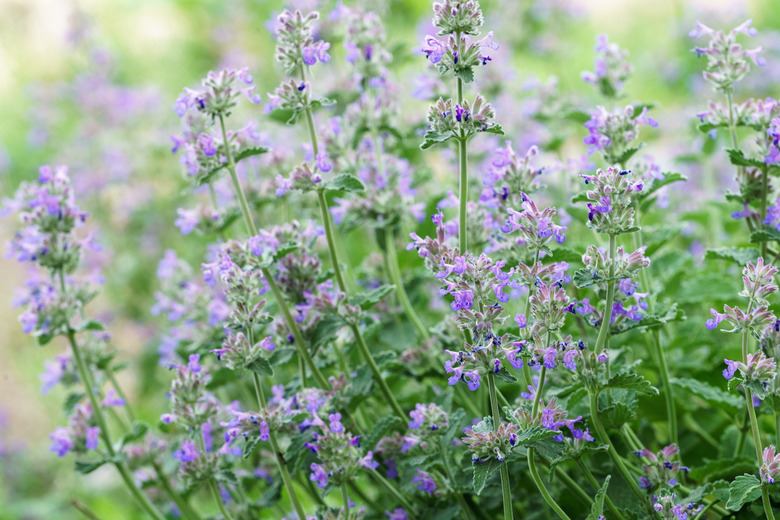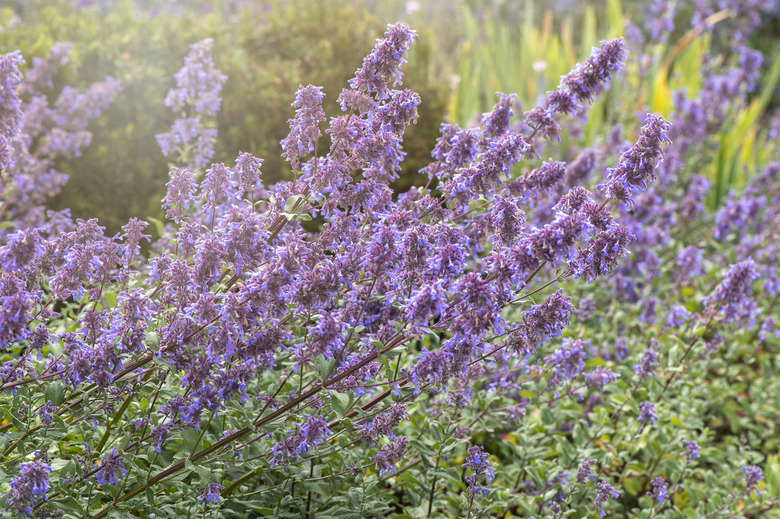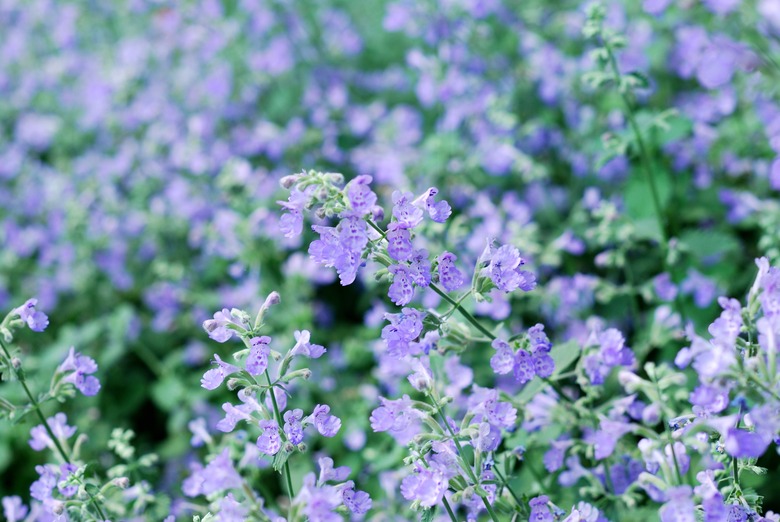How To Grow Catmint
We may receive a commission on purchases made from links.
Mint plants have a bad reputation for being a tad invasive, and it's one they have certainly earned. But don't let this deter you from growing catmint (Nepeta spp., USDA zones 3-8). Catmint is easy to grow; it thrives on neglect, and you can easily find sterile plants incapable of spreading via seed. As such, catmint won't seed itself and take over your garden like other mint plants can.
Catmint won't attract unwanted felines to your garden either. As long as you don't grow the catnip plant (Nepeta cataria, zones 3-9) specifically, your garden should not attract any unwanted attention from any wandering feline friends.
This hardy perennial is an excellent choice for new gardeners, as it is long-lived and has very few pests. What it does have is a long blooming season that produces attractive lilac, pink, blue and white flowers, which it bears proudly atop long stems up to 3 feet tall. Catmint is also graced with aromatic gray-green foliage that has a delicate look.
Best Uses for Catmint
Best Uses for Catmint
Spreading 2 to 3 feet wide, catmint plants are often used as ornamentals or to fill empty spaces in the garden. Because it is so hardy, catmint is also frequently planted in troublesome areas, like rock gardens, and on heavy clay soils where other plants may refuse to grow. Catmint adds a classic, cottage-garden feel to the landscape but sometimes gets a bit leggy, so it is best to keep it out of formal gardens.
Catmint is drought tolerant and attracts several beneficial insects, including bees and butterflies. It may also lure hummingbirds to your garden. Its minty leaves repel rabbits, voles and deer, making it an excellent choice in areas where these critters create garden problems. It also has a pleasant odor that works well near patios and other outdoor seating areas.
How to Grow Catmint
How to Grow Catmint
- Common Name: Catmint
- Botanical Name: Nepeta spp.
- When to Plant: In spring after the last frost
- USDA Zones: 3-8
- Sun Exposure: Full or partial sun
- Soil Type: Moist, well-drained soil is preferable, but the plant is not fussy
- When it's in Trouble: Holes in leaves, discolored leaf spots
- When it's Thriving: Strong, upright stems and leggy growth
Starting Catmint From a Seedling
Catmint is extremely easy to start from seed, which is why you should never do it. If you start a catmint plant from a seed, you will end up with a fertile plant capable of producing seeds of its own — and produce them it will in abundance. Because many mint-family plants self-seed and take hold so easily, unprepared gardeners find themselves in the rare position of trying to figure out how to stop their plants rather than how to grow them.
It is far better to plant catmint from sterile plants propagated at the nursery through cuttings or division. Varieties like Faassen's catmint (Nepeta x faassenii) can't self-sow and will enhance your garden without taking over.
Whether you are planting a rooted cutting or a clump of catmint divided from another plant, dig your planting hole large enough to cover the entire root ball. Space the plants about 2 feet apart so they have room to spread without compromising the air circulation between them.
You can work compost into your soil before planting if you know your soil to be horribly deficient, but doing so is not strictly necessary for catmint. Gently water your catmint after planting it in its new home and mulch around your new plants. Doing so will reduce weeds and help preserve soil moisture.
In What Zone Does Catmint Grow Best?
In What Zone Does Catmint Grow Best?
Catmint grows well in USDA plant hardiness zones 3 through 8, but exactly where you live will impact the variety you choose. The popular 'Blue Wonder' (Nepeta racemosa 'Blue Wonder') catmint cultivar is hardy in zones 3 through 8 but may not survive the winter in colder zones. If you live in a colder area like zone 3, opt for a more cold-hardy cultiva that grows well there.
If you are not sure what type of catmint will grow well in your area, visit your local garden center or cooperative extension service. They will know which types will grow in your area and garden centers likely will sell only those types. If you are purchasing plants online, read the description carefully and make sure you choose a type that will grow well where you live.
When Should You Plant Catmint?
When Should You Plant Catmint?
Catmint isn't all that particular about planting times. You can plant it any time in the spring after the last frost or at any time during the summer or early fall. If you can, it is best to plant catmint in the spring or summer. This gives the plant time to establish itself before winter dormancy sets in. You are more likely to lose catmint plants that are put in the ground too close to winter.
Soil, Sunlight and Water Recommendations for Catmint
Soil, Sunlight and Water Recommendations for Catmint
Catmint thrives in full sun but will tolerate some afternoon shade, especially in very warm areas. During the first season, keep the soil around your catmint plants consistently moist but never soggy. Once established, catmint tolerates drought well, and you probably won't need to water it. Catmint won't tolerate soggy feet, however, so avoid planting catmint in areas where you have drainage issues unless you fix them.
Avoid fertilizing your catmint plants and leave them to their own devices instead. Fertilized plants tend to flop open in the middle and become ungainly. If your plant does this, solve the problem by cutting back the plant. For more flowers, you should also cut back the plant by a third after its first bloom.
When the plant dies back in late fall or early winter, leave the withered leaves on the plant. They will provide a bit of extra insulation to the plant during the winter months. You can remove this plant debris in the spring as your plant wakes up and starts growing again.
Catmint is a perennial plant that looks nice with very little help from you. After about four years in the garden, however, it starts to look a little run down. To alleviate the issue, dig up and divide the plants to restore their youthful vigor.
How to Propagate Catmint
How to Propagate Catmint
There are two ways to propagate catmint plants. One is by taking a cutting. Do so in the spring, cutting a healthy stem about 4 inches long from the plant. Strip any leaves from the cutting and plant it in loose soil or sand. You can dip the cutting in rooting compound if desired, but you don't have to do so. Catmint will form roots well without it.
You can also propagate catmint by dividing a plant in the spring. Dig up the parent plant and make a vertical cut to shear through the root ball. Make sure each division has a nice clump of roots and at least three or four stems on it. Once you have divided the plant, you can replant your divisions about a foot apart, plant them in a new area or give them away to someone who wishes to grow catmint.
How to Harvest Catmint
How to Harvest Catmint
Most home gardeners grow catmint purely for aesthetics, but the plant's leaves are edible. If you want to experiment with eating your catmint, cut a few leaves off the top of the plant just as the flowers are beginning to bloom in the spring. Lay the leaves out to dry and then store them in an airtight container.
You can then use your catmint to make a tea or enhance the flavor of soups and sauces. Herbalists have used catmint to relieve coughs, congestion and menstrual cramps as well. As is true of any herb, it is important that you consult your doctor before attempting to use catmint as a medication of any sort.
Common Pests and Other Problems for Catmint
Common Pests and Other Problems for Catmint
While humans like the minty smell and taste of catmint leaves, most animal and insect pests don't. Thrips are an exception to the rule. If you see them on your plants, a simple insecticidal soap will be enough to get rid of them.
Aphids, cabbage loopers, squash bugs and other common garden pests will usually leave catmint alone. You can use this fact to your advantage by planting catmint next to plants that insects do like, hopefully keeping them away.
Common Diseases for Catmint
Common Diseases for Catmint
Catmint is a relatively disease-free plant, but there are a few things for which to check. One is blight. Caused by a fungus, blight causes small, yellow-ringed dots to appear on plant leaves. The best way to combat it is to keep the garden clean and free of debris. Dispose of infected plants immediately before blight can spread.
In cooler regions, bacterial leaf spot can also pose problems. Once your plants have it, there is no cure except removing and destroying infected plants. As is true of blight, good garden hygiene practices usually keep bacterial leaf spot easily in check. The same is true of septoria leaf spot, which causes round gray or black dots on leaves starting with older foliage and eventually spreading to the entire plant.
Catmint is also susceptible to root rot but only if it is allowed to sit in puddles of water. You can prevent root rot by planting catmint in areas with good drainage and making sure you are not overwatering.


